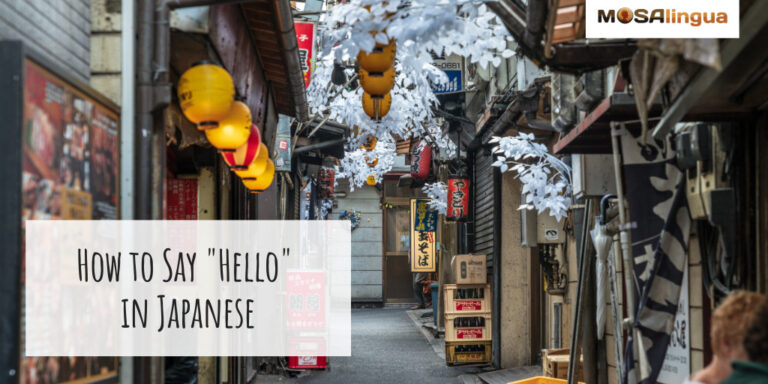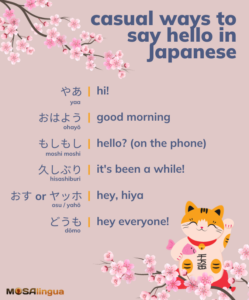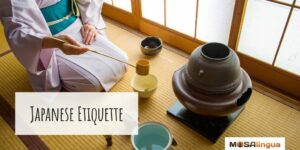Greetings are often among the first expressions people want to learn when they’re studying a new language. After all, knowing how to say hello is crucial for starting a conversation or any other type of interaction. So, how can you say hello in Japanese? In this article, I’ll introduce a few different ways you can greet people as you go throughout your day. Learning these phrases won’t just expand your Japanese vocabulary, they might also reveal some interesting information about Japanese culture!

How to Say Hello in Japanese
I’m sure you’ve heard the term konnichiwa, commonly translated as “hello” in English. This is certainly one of the most common ways to greet a person, but it’s far from the only option! In fact, there are many different expressions that can be used based on the time of day and your relationship with the person you are addressing.
Japanese greetings, or aisatsu (挨拶), are a standard part of social exchanges, including both the hello and the goodbye.
Also, remember that it’s standard in Japan to bow your head when you offer a greeting and a farewell. This gesture is a sign of respect called ojigi (お辞儀).
The Japanese language reflects the culture’s preference for social hierarchies and various degrees of politeness. So it’s always important to take stock of your situation and to remember the degrees of formality and informality that you might need to employ.
Generally speaking, you should use the formal address when speaking to:
- a stranger
- a person older than yourself
- a person whose status (professional, social, or symbolic) is higher than your own
Informal language can be used when you’re speaking to:
- someone younger than yourself
- a friend or family member
Now that we’ve covered the different situations you might find yourself in Japan, let’s move on to our main topic: different ways to say hello in Japanese.
Quick Guide: How to Say Hi in Japanese
| Hiragana | Romaji | Pronunciation | English Translation | Application | Audio |
|---|---|---|---|---|---|
| おはよう | Ohayō | Oh-ha-yo | Good morning | Casual | |
| おはようございます | Ohayō gozaimasu | Oh-ha-yo goh-zah-ee-mahs | Good morning | Polite, Professional | |
| こんにちは | Kon'nichiwa | koh-nee-chee-wah | Hello | Polite, Professional | |
| こんばんは | Konbanwa | kohn-bahn-wah | Good evening | Polite, Professional | |
| お久しぶりです | Ohisashiburi desu | Oh-hi-sa-shi-bu-ri des | It's been a while! | Polite | |
| 久しぶり | Hisashiburi | Hi-sa-shi-bu-ri | It's been a while! | Casual | |
| おす / おっす | Osu / Ossu | Oh-shu / Os | Hi | Casual (typically masculine) | |
| ヤッホ | Yahō | Yah-ho | Hi | Casual (typically feminine) | |
| どうも | Dōmo | Doh-moh | Hey everybody! | Casual (typically masculine) |
8 Ways to Say Hello in Japanese
おはよう (Ohayō) – Good morning
おはよう is the greeting you’ll use to address your friends and family from the time you wake up until about 11:00 or lunchtime.
It’s written in hiragana as「 おはよう」. Its kanji (早 – はや – haya) means “early” or “fast” following the honorific お – o. A common, native-sounding way to say good morning in Japanese is to draw out the final “o” sound, pronouncing an energetic おはよー (ohayooo)!
Also, if you’re a movie fan, I recommend the film おはよう (Ohayō) by director Yasujirō Ozu. It’s a wonderful movie about a family living near Tokyo after World War II. It examines themes of childhood and social conventions and raises questions about manners and consumerism. And it’s funny!
おはようございます (Ohayō gozaimasu) – Good morning (polite)
To form the polite version of the morning greeting, you simply need to add “gozaimasu” and say おはようございます (Ohayō gozaimasu). Because this is the more formal expression, use it in situations where you should show someone respect.
Start improving your Japanese today

Good news: we can help!
More good news: you can get started for free! With your free trial, you can test drive the most effective way to learn Japanese for the next 15 days!
Vocabulary flashcards, videos with subtitles, audiobooks, articles adapted to your level—with MosaLingua Premium (Web & Mobile), you’ll have access to all this and more. Get started right now. It’s free—and risk-free—to try!
こんにちは (Kon’nichiwa) – Hello (daytime)
This is almost always one of the very first words Japanese learners see. But what does konnichiwa mean? こんにちは means “hello” in Japanese, though it’s not used quite as much as you might imagine. It’s actually closest to the Japanese for “good afternoon.” It’s used from the afternoon until early evening.
こんにちは is fairly universal, but it is on the polite side. It’s most often used in formal situations, such as professional exchanges. As a result, it would sound a bit off to use this phrase to greet family members or close friends.
You’ll always find it written in hiragana. こんにちは literally means “today”:
こん (this) + にち (day) は (thematic particle)
Be careful, in the case of こんにちは, the last character is an exception to pronunciation rules. Because it’s a particle, it’s pronounced [wa].
It’s also important to note the difference between this expression and 今日は which, according to the context, means “these days” or “today.”
The word こん・にち・は is pronounced in three even syllables: kon-nichi-wa. There is no stress on any particular syllable.
こんばんは (Konbanwa) – Good evening
We use こんばんは from the late afternoon to early evening, until the sun sets. Just like こんにちは (konnichiwa), the Japanese for good evening (konbanwa) is relatively formal and you won’t use it among friends.
Just like こんにちは, the final character, は, is an exception and is pronounced [wa] (because it’s a particle).
You’ll always find it written in hiragana. こんばんは literally means “tonight”:
こん (this) + ばん (night) + は (thematic particle).
Be careful, because you might also come across this phrase written in kanji 今晩は (kon ban wa). When written in kanji, it means “tonight.”
お久しぶりです (Ohisashiburi desu) – It’s been a while!
There’s a specific expression to use when you run into someone you haven’t seen in a long time:
お久しぶりです! (Ohisashiburi desu!)
This is a very common phrase, and it’s used to express surprise and/or pleasure at running into a friend or acquaintance after a period apart.
If you’re talking to a friend, you can make the expression informal by removing the honorific お (o) and the element です (desu), simply saying 久しぶり (hisashiburi). This is a short and practical expression, roughly equivalent to the English “long time no see!”
おす or おっす (Osu or Ossu) – Hey
Another, more casual way to say hello in Japanese is to use the expression おす or おっす (ossu or osu). Both versions are correct. This word is most commonly used by boys or young men to greet one another.
It originates from the contraction of おはようございます (ohayō gozaimasu), and has military roots, where short responses are common.
ヤッホ (Yahō) – Hi, hiya
If おす or おっす (ossu or osu) is most often used among men and boys, the feminine counterpart for hi in Japanese is ヤッホ (yahō). This is another very casual greeting, generally used among children and close friends.
ヤッホ (yahō) is also a kind of exclamation used to get the attention of a friend or young person (like, “yoohoo!”). You’d typically follow it up with the name of the person you’re calling to.
どうも (Dōmo) – Hey
There are many different applications for the word どうも (dōmo), including using it as a friendly greeting. This is one of the more casual Japanese greetings, to be used in relaxed situations.
Imagine you’re meeting up with a group of friends. Instead of greeting each person individually, you can simply use one どうも (dōmo) to address the whole group. It’s generally and most commonly used among men.
Next Steps
We hope you enjoyed our article on how to say hello in Japanese! Want to learn more Japanese? We think you’ll like these posts:





Comments